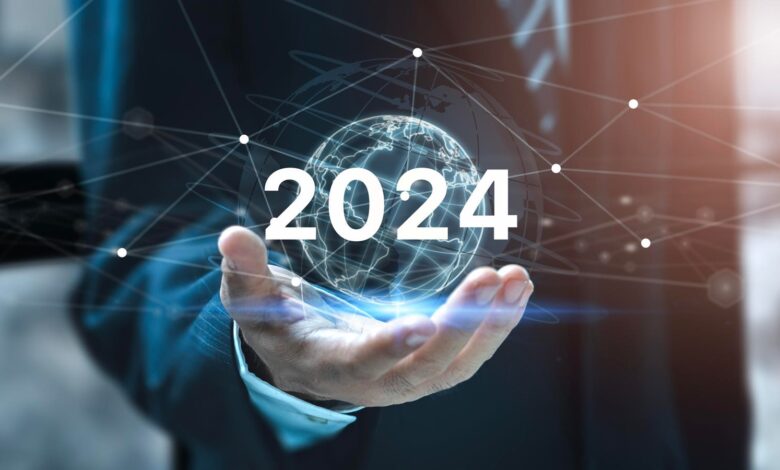Navigating The Cybersecurity Landscape In 2024

As we set our sights on 2024, the cybersecurity landscape is on the cusp of substantial … [+]
We can collectively acknowledge that 2023 was a momentous year, marked by remarkable progress and significant challenges in the realm of cybersecurity. As we set our sights on 2024, the cybersecurity landscape is on the cusp of substantial transformations characterized by mounting complexity, evolving threats and an increasing acknowledgment of the necessity for sophisticated and integrated security solutions. Positioned at the crossroads of unprecedented technological advancements and escalating cybersecurity challenges, individuals and organizations alike must gear up for the journey ahead. Here, we present overarching cybersecurity predictions for 2024 that warrant attention from everyone in the field.
1. Rise In Ransomware Attacks
Ransomware attacks, a persistent threat in recent years, are expected to continue their upward trajectory in 2024. Cybercriminals are likely to target not only corporations, but also critical infrastructure and municipal services. The potential for disruption and financial loss remains significant, necessitating organizations to prioritize robust backup solutions, employee training and vulnerability assessments to mitigate the impact of ransomware.
2. Increased AI-Powered Attacks
Artificial intelligence and machine learning will play an increasingly prominent role in cyberattacks in 2024. Expect cybercriminals to leverage AI and ML to automate and enhance their capabilities, making attacks more sophisticated and adaptive. Cybersecurity professionals must harness the power of AI themselves to stay one step ahead of these evolving threats.
3. Flipside: AI As A Cybersecurity Tool
The rapid advancement of AI presents both opportunities and challenges in cybersecurity, and the same tools that equip attackers with advanced capabilities can also serve useful in cyber defenses. A diligent approach is needed to apply AI effectively in cybersecurity, ensuring it addresses specific problems within the tech stack.
4. IoT Vulnerabilities
The expanding Internet of Things landscape will introduce new vulnerabilities in 2024. Many IoT devices lack adequate security measures, making them attractive targets for hackers. Addressing IoT security issues promptly is essential, as these devices continue to become more integrated into daily lives and critical infrastructure. Manufacturers and consumers must prioritize security features, firmware updates and robust authentication mechanisms to protect against IoT-related threats.
5. Electric Vehicle Hack Apocalypse
The interconnected nature of modern vehicles, especially electric ones, presents a potential avenue for cyberattacks. As most vehicles on the road today rely on numerous chips, computers and remote connectivity, vulnerabilities are prevalent. A catastrophic attack affecting fleets of electric vehicles, charging stations and connected apps is a conceivable threat, and cybersecurity measures must address the unique challenges posed by the electric vehicle ecosystem.
6. Quantum Computing Threats
Advancements in quantum computing will reshape the cybersecurity landscape in 2024. The immense computational power of quantum computers could break existing encryption algorithms, necessitating the development of new encryption and security measures. Organizations should stay informed about quantum computing developments and consider investing in quantum-resistant cryptography.
7. Data Velocity And Hybrid Infrastructures
The increasing velocity of data accumulation and movement across hybrid and multicloud infrastructures poses significant security challenges. A data-centric approach to cybersecurity is essential, focusing on securing data and the critical paths through which it flows. This involves aligning security with the entire data lifecycle, from collection to utilization.
8. Need For DevSecOps
With a growing diversity of APIs and applications creating a larger attack surface, DevSecOps (development, security and operations) practices will prove critical for the secure development and deployment of software. Infrastructure, governance and platform cohesiveness will be critical to success in this area.
9. More Zero Trust Adoption
Zero Trust principles emphasize the verification of every user and device, regardless of location, and are integral to modern cybersecurity strategies. Adoption of this security model is expected to expand further in 2024 as organizations recognize the need to enhance network security and protect sensitive data, especially in an era of remote work and distributed computing.
10. Stricter Data Privacy Regulations
Governments worldwide will continue implementing more stringent data privacy regulations in 2024, placing greater responsibility on organizations to secure customer and user data. Non-compliance can result in hefty fines and reputational damage, and legislation continues to evolve. Companies should invest in robust data protection mechanisms including encryption, access controls and privacy-aware data management practices.
11. Additional Supply Chain Attacks
Supply chain attacks will persist, with threat actors focusing on compromising software and hardware providers to infiltrate downstream targets. These attacks can have geopolitical roots and significant, far-reaching consequences. Businesses must implement stringent supply chain security measures, conduct thorough vendor assessments and adopt a proactive approach to detecting and mitigating potential threats.
12. Biometric Authentication Challenges
Biometric authentication methods, such as fingerprint and facial recognition, are becoming increasingly prevalent. With their widespread adoption, attempts to bypass or compromise these systems are expected to rise. Cybersecurity professionals must continuously assess and enhance biometric authentication systems to stay ahead of potential threats.
A Pivotal Year Ahead
As we approach 2024, a pivotal year for cybersecurity, staying informed about emerging threats and leveraging the latest security technologies is crucial. Let’s collectively work toward a safer digital future by navigating these challenges and seizing the opportunities that lie ahead.



